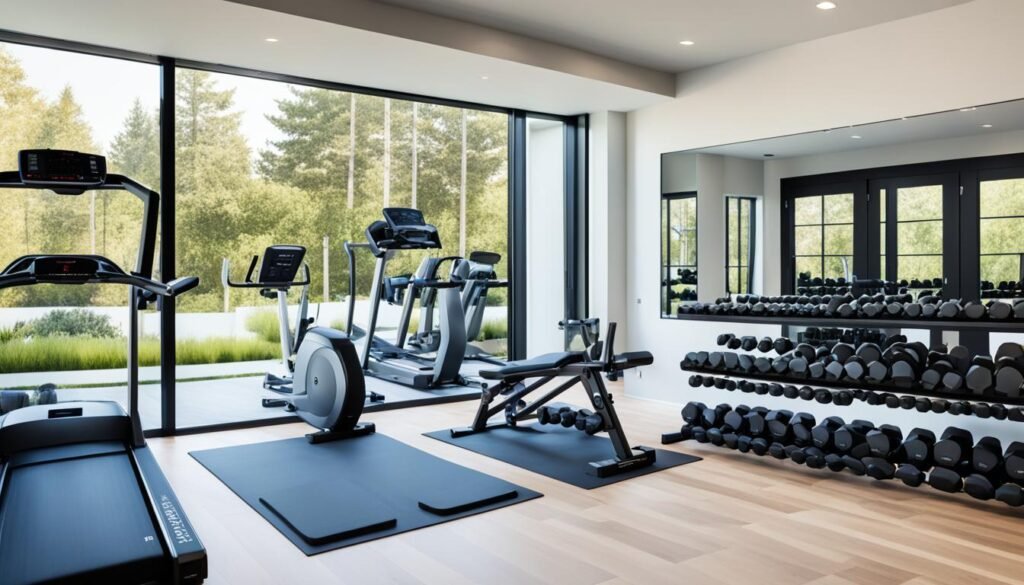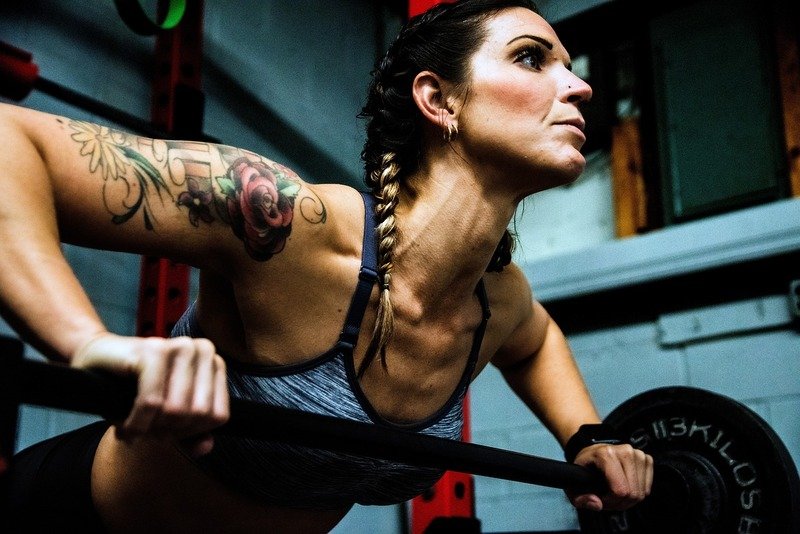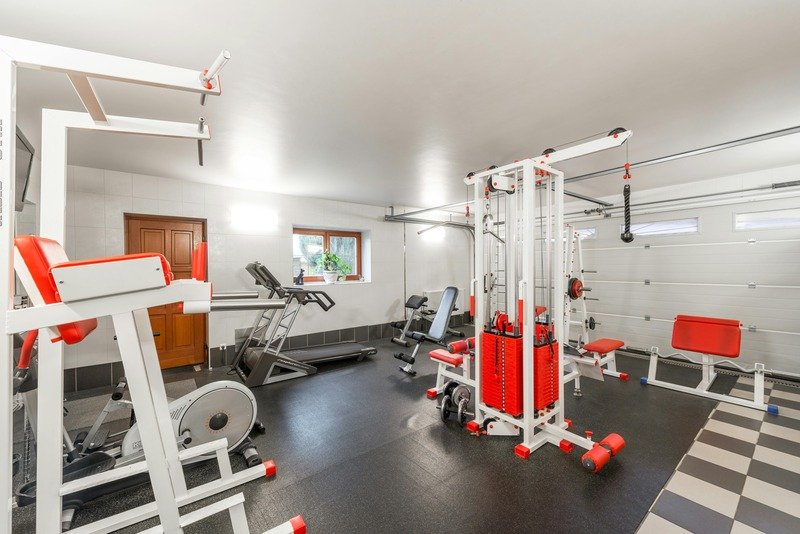We independently test and review fitness products using a research-based approach. If you buy through our links, we may earn a small commission at no extra cost to you. Read our Disclosure
Are you ready to take control of your fitness journey? Dive into our comprehensive guide to the best all-in-one home gym systems and essential equipment.
Our experts gathered insights from over 50 home gym machines, rigorously testing each product and assigning a score from 1 to 5 based on construction, versatility, performance, and value. The REP Fitness PR-4000 Power Rack remains our top overall pick, thanks to its strong 3×3-inch 11-gauge steel frame and high level of customization.
Whether you’re looking to build strength, boost cardiovascular health, or just stay fit, this guide will help you select the right equipment to fit your goals, budget, and available space. Get ready to turn your home into a fitness haven.

Why a Home Gym Beats the Commercial Crunch
Having a home gym provides significant benefits that make it an undeniable winner for dedicated fitness enthusiasts.
Convenience & Discipline
A home gym eliminates travel time and allows you to work out whenever you want, fitting seamlessly into a busy schedule. This autonomy fosters willpower and discipline, as you are fully in charge of your fitness progress without the pressure or distractions of a crowded public gym.
Family Time & Privacy
Skipping the commute means more time with family, which is especially valuable for parents setting a positive example. Furthermore, you enjoy the privacy and comfort of training alone, allowing you to focus completely on hitting new personal bests.
Home Gym vs. Commercial Gym: Cost Comparison
While the initial investment in a home gym is higher, it proves to be the cheaper option over time. The average commercial gym membership in the US is approximately $58 a month, totaling nearly $700 a year. Over a 10-year period, this amounts to roughly $7,000 spent—not including gas, parking, or specific class fees.
Compare this to a robust, long-lasting home setup:
| Setup Type | Initial Cost (Estimate) | Annual Recurring Cost | 10-Year Cost (Approx.) |
|---|---|---|---|
| Commercial Gym | $0–$150 (Enrollment) | $700 | $7,000+ |
| Basic Home Gym | $1,300 (One-Time) | $0 (Excluding electricity/maint.) | $1,300–$1,500 |
A home gym offers flexibility and convenience, which is priceless when it comes to long-term adherence to your fitness plan.
Top All-in-One Home Gym Systems
The term “all-in-one” can mean two things: a highly versatile power rack setup or a single, specialized machine. Here are our top picks across both categories.
1. REP Fitness PR-4000 Power Rack (Top Pick: Versatility)
The PR-4000 is the ultimate foundation for strength training. It features Westside hole spacing, a massive 1,000-pound weight capacity, and incredible customization. You can add modular attachments like landmines, dip stations, lat pulldowns, and functional trainers, making it perfect for powerlifters, bodybuilders, and CrossFit athletes alike.
2. Total Gym FIT (Top Pick: Bodyweight/Pilates)
This classic system uses sliding bench movement and adjustable resistance to perform over 85 exercises, utilizing your own body weight as resistance. It’s often available at a significant discount and is a space-saving solution for full-body strength and conditioning. It supports up to 450 pounds and is backed by a steel construction and a lifetime warranty on the frame.
3. Tonal Smart Home Gym (Top Pick: Technology)
The Tonal represents the cutting edge of connected fitness. This sleek, wall-mounted unit uses digital weight (up to 200 lbs) powered by AI. It provides real-time feedback on your form, adjusts resistance dynamically throughout the lift, and offers a vast library of guided workouts with live instructors.
4. Marcy Smith Machine Gyms (Top Pick: Budget Multi-Function)
The Marcy line (like the MWM-990 or MWM-4965SC) offers an affordable, comprehensive solution centered around a guided Smith Machine. These machines are great for safe solo strength training and typically include components like a pec deck, leg developer, and lat bar for a full-body workout.

Essential Home Gym Equipment (Starter Kit)
Creating an effective home gym doesn’t have to break the bank. You can start with a few versatile and strong pieces of must-have home gym equipment that form a basic, effective setup for a total cost around $1,300.
| Equipment | Purpose | Recommended Example/Spec |
|---|---|---|
| Barbell | Heavy Compound Lifts | Quality Olympic barbell (28.5 mm shaft) |
| Squat Rack w/ Pull-up Bar | Safety, Foundation, Upper Body | Titan Fitness T-3 Series Power Rack (1,100 lbs capacity) |
| Bumper Plates | Versatile Weight | Durable plates designed to withstand drops |
| Kettlebell | Versatility, Conditioning | Single, medium-weight kettlebell for swings and carries |
| Gymnastics Rings | Upper Body, Core | Elevates push-ups, dips, and rows |
| Jump Rope | Affordable Cardio | High-speed rope for warm-ups and conditioning |
| Flooring | Protection | Affordable and durable horse stall mats |
Factors to Consider When Buying a Home Gym
Setting up your personal fitness space requires careful planning around three key elements: space, budget, and fitness goals.
Space
Measure your dedicated gym area first. Look for equipment that is compact, foldable, or modular (like the REP rack system) to maximize the utility of your square footage. Remember to account for overhead clearance and space around the equipment for movement.
Budget
Set a realistic budget that covers the equipment, maintenance, and any necessary monthly subscription fees (e.g., Tonal, iFIT). Prioritize buying quality foundational pieces (like a rack or barbell) that will last for years, rather than filling your space with low-quality gear.
Fitness Goals
Define what you want to achieve. If you want to focus on powerlifting, a rack and barbell are mandatory. If you seek flexibility and low-impact strength, a Total Gym or a smart system like Tonal might be a better fit. Choose equipment that is flexible and can evolve as your workout needs change.
Setting Up and Maintaining Your Space
Layout and Organization
A well-organized home gym makes working out better and safer. Group similar items together (free weights, cardio, stretching) and ensure there is enough clear space around your rack for compound movements like squats and deadlifts. Investing in storage (pin-and-plate holders) is crucial for efficiency.
Home Gym Maintenance
Keeping your equipment in top shape is essential for longevity and safety. Follow these steps for how to maintain a home gym:
- Clean: Wipe down all gear after each use with a damp cloth and mild soap to prevent corrosion from sweat and chalk buildup.
- Inspect: Regularly check for loose parts. Tighten any loose bolts or screws immediately.
- Lubricate: Use lubricant on moving parts (e.g., cable pulleys, Smith Machine rods) as recommended by the manufacturer to keep things running smoothly.
Incorporating Technology
The home gym experience is constantly evolving with smart home gym tech.
- Tonal uses AI to change weights and provide real-time form feedback.
- NordicTrack Fusion CST and others connect with platforms like iFIT, offering interactive classes that blend strength and cardio.
These technologies offer personalized workout tips, virtual coaching, and motivational features that replicate the high-end experience of a commercial gym, ensuring you stay engaged and push past plateaus.
FAQ
What are the key advantages of having a home gym? Home gyms offer ultimate convenience, saving time by eliminating the commute. They also boost mental discipline and provide privacy, allowing you to train on your own schedule without distractions.
How does the cost of a home gym compare to a commercial gym membership? While the upfront cost is higher ($1,300+ for a basic setup), a home gym is significantly cheaper over the long term. A commercial gym membership can cost over $7,000 in ten years, whereas a quality home setup is a one-time purchase.
What is the best all-in-one home gym system? The REP Fitness PR-4000 Power Rack is our top pick for versatility and strength, customizable for powerlifting and CrossFit. For tech-focused training, the Tonal Smart Home Gym is unrivaled.
What are the essential pieces of equipment for a basic home gym? The foundation should include a barbell, a squat rack with a pull-up bar, and bumper plates. Complementary essentials include a kettlebell, gymnastics rings, and durable horse stall mats for flooring.
What factors should I consider when buying a home gym? The three main factors are: Space (ensuring the equipment fits), Budget (prioritizing quality over quantity), and Fitness Goals (choosing gear that aligns with your strength, cardio, or versatility needs).
How do I maintain my home gym equipment? The best maintenance involves three simple steps: regular cleaning after each use, frequently checking and tightening any loose bolts or screws, and applying lubricant to moving parts per the manufacturer’s directions.


